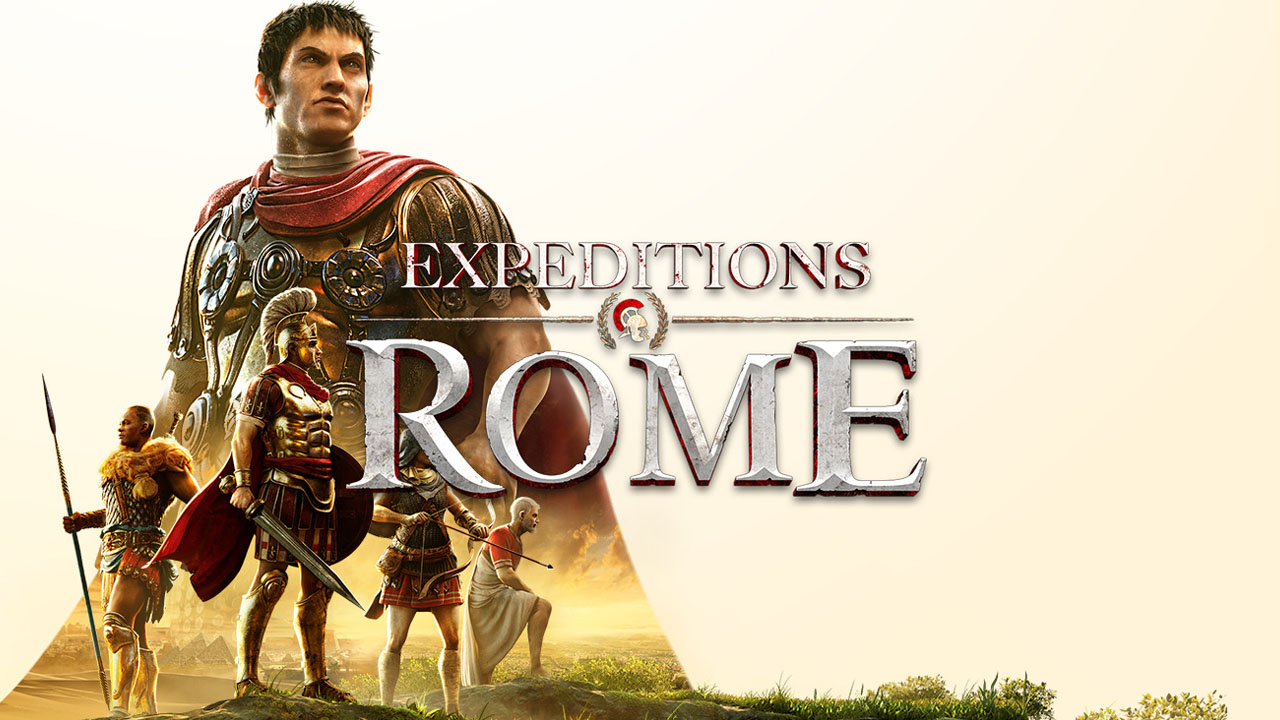
Expeditions: Rome is the latest installment in a series of historical RPGs that have largely gone unnoticed by a lot of gamers. Logic Artists started the Expeditions series in 2013 with Expeditions: Conquistador. This first game in the series was an exploration-focused RPG with a hefty dose of resource management. As you can probably gather from the name, you played as a conquistador leading an expedition deep into the rainforests of the New World. When starting my Expeditions: Rome review, it’s clear this is bigger than any of their previous outings.
The game mixed exploration and survival elements where you had to set up and manage your camp every night. You would assign camp duties, like making medicine or preserving meat, to your various party members. As an RPG, there was plenty of trading and negotiating with the natives, including some moral choices that could affect the long-term stability of the Aztec Empire. Rounding out the package was a fairly decent turn-based tactical combat system.
While it was pretty unpolished and clunky in places, Expeditions: Conquistador was still a really unique and engaging RPG. Logic Artists took this same basic formula and refined it with Expeditions: Viking, a standalone follow-up that released a few years later. Now, the developers are moving to the ancient Mediterranean with the latest game in the series, Expeditions: Rome.
Expeditions: Rome takes many of the concepts and mechanics from the previous two games and refines them even further. While the exploration and survival elements are a bit deemphasized compared to the other games, Expeditions: Rome is definitely the most polished game in the series thus far. It’s also the first great RPG of 2022 – read my Expeditions: Rome review to find out more!
Expeditions: Rome
Developer: Logic Artists
Publisher: THQ Nordic
Platform: Windows PC
Release Date: January 20th, 2022
Players: 1
Price: $44.99
Buy Expeditions: Rome on Fanatical (Affiliate)

Expeditions: Rome is set during the waning years of the Roman Republic. You play as the son (or daughter) of a wealthy Roman statesman who dies under suspicious circumstances. Everyone strongly suspects your father was poisoned by a political rival named Vitellius Scaevola. These suspicions are seemingly confirmed with Scaevola wastes no time absorbing your family’s wealth by marrying your older sister. Unfortunately, there is no hard evidence to prove Scaevola’s involvement with your father’s murder.
With your family villa seized and your mother and sister effectively being held hostage, you are sent away for your own protection. Your father’s old friend Lucius Licinius Lucullus agrees to take you in, offering protection and the promise of revenge.
Lucullus is currently leading a campaign against Mithridates in Asia Minor during the final years of the Third Mithridatic War. While you are sent to Lucullus to be a mere student learning the ways of Roman politics and warfare, you soon prove yourself worthy enough to be promoted to Legatus. It’s here in Asia Minor that you receive your trial by fire, leading your own legion against the enemies of the Republic to become a rising war hero.
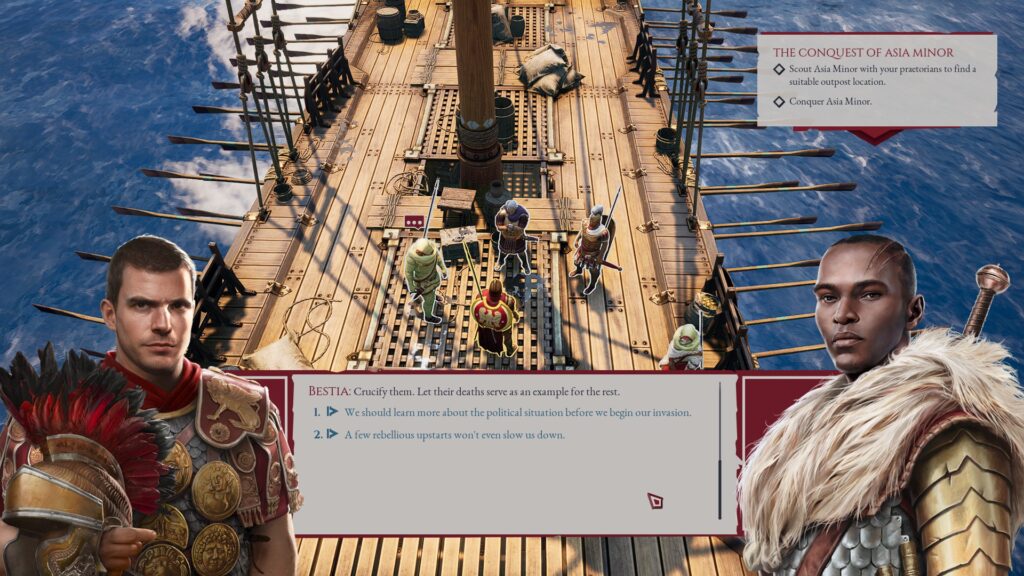
Your time in Expeditions: Rome will be split between your duties as a Legatus, and your quest for vengeance against Scaevola. You will travel across Asia Minor, North Africa, Gaul, and Rome as you both quelle rebellious territories, and try to find clues that can incriminate Scaevola.
As with previous Expeditions games, Rome sits in the “historically inspired” camp with its setting. You’ll meet plenty of real historical figures, and the game does an admirable job keeping things moderately authentic. While the game references plenty of real events, Expeditions: Rome is ultimately an alternate history RPG. There is even a character death a few hours in that exists solely to let players know that the game’s events will intentionally deviate quite a bit from real history.
While Expeditions: Rome is moderately authentic on a surface level, the game does bend the rules a little in places. After all, you can choose to play as a female character in Rome’s notoriously patriarchal society. The game’s story actually acknowledges this, however.
The game’s dialogue changes quite dramatically in places if you play as a female character, and some options change as well. The game’s overall story and choices are still largely the same, but many characters will berate and question your capabilities if you choose to play as a woman.
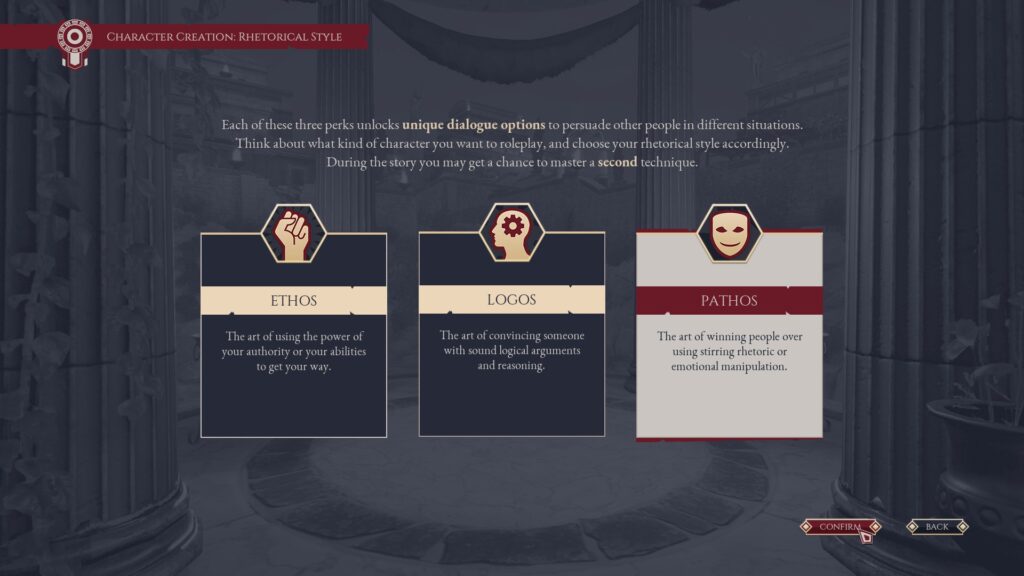
In terms of roleplaying skills, you can pick one of three rhetorical styles at the start of the game. These rhetorical styles are kind of like morality systems in other games, opening up new dialogue options and choices from time to time. Ethos focuses on threats and intimidation, Logos is about logical and rational arguments, and Pathos uses appeals to emotion to manipulate people to your side.
You’ll be accompanied by a set of loyal companions throughout your adventures across Rome. Each companion has their own impact upon the game’s story. You can get to know them better by chatting with them at camp, and can help them out by pursuing side quests related to their personal problems and backstory. Some of them can even be romanced.
Caeso Quinctius Aquilinus is a veteran centurion that Lucullus assigns to you as a bodyguard and advisor. Bestia Tabat is an African slave that earned his freedom in the gladiator pits of Rome. Julia Calida is a woman who disguised herself as a man to flee from problems back at home. Syneros is your mentor and personal servant. Finally, Deianeira is a Scythian woman that you rescue from slavery.

Each of your companions are interesting and enduring characters with their own personality quirks. Your personal bonds with them can strengthen or shatter depending on your choices throughout the game.
While the companions are the main characters of the game, you’ll have plenty of other soldiers under your command. You will need to bolster your party by recruiting centurions and praetorians. These characters are acquired by visiting the recruitment tent at your camp, and are randomly generated.
Each of these recruits have personality traits, perks, skills, gain experience, and can be equipped with weapons and armor just like yourself and your companions. Their role in your party depends on if you assign them to be a praetorian or a centurion.
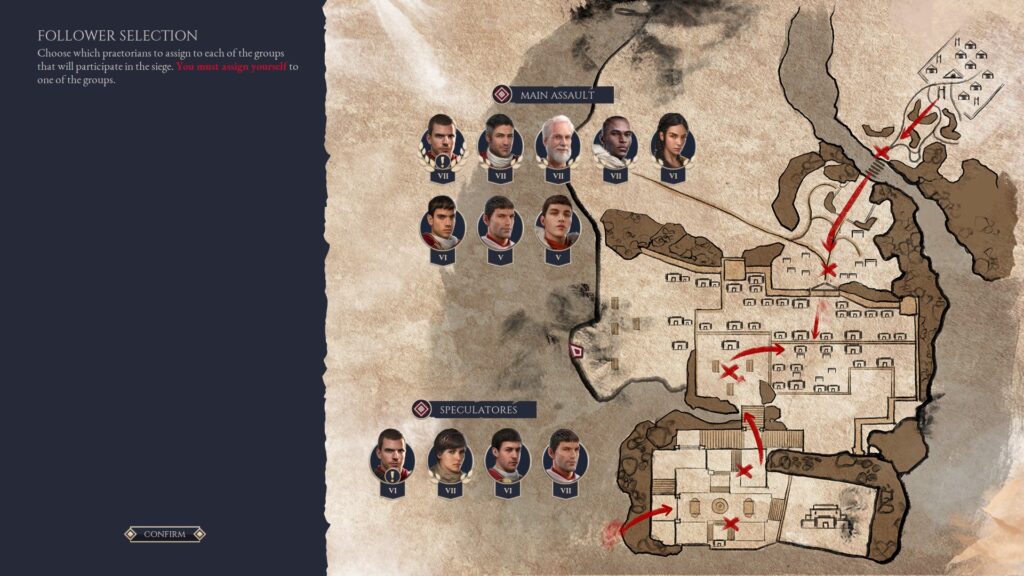
Centurions lead your legion in the game’s large-scale battles to take territory or fend off enemy armies. In this role, the centurions will make use of various military skills to push battles in your favor. Praetorians are your personal bodyguards and will adventure with you as you explore the world map.
You will need a decent number of praetorians because of the sheer number of uses they have. Sometimes you’ll stumble across a random encounter that can be solved by sending away one of your praetorians for a while. Other times you may need to leave some at camp performing tasks like crafting items, researching new stratagems, or treating injured party members.
You’ll need a good mix of praetorians from each class and with a nice variety of skills. While you can get away with using just your companions in many battles, there are times where you’ll specifically need praetorians. Pacification missions consist of a single companion leading up to five praetorians. Likewise, each region has a few large, multi-stage set piece battles where you’ll need to create several parties of characters to complete simultaneous missions.
Unlike companions, your praetorians and centurions can die permanently during combat or from injuries. The monetary cost to recruit a praetorian is pretty low, but they are far from expendable. Losing an experienced soldier that has been with you for a while definitely stings.
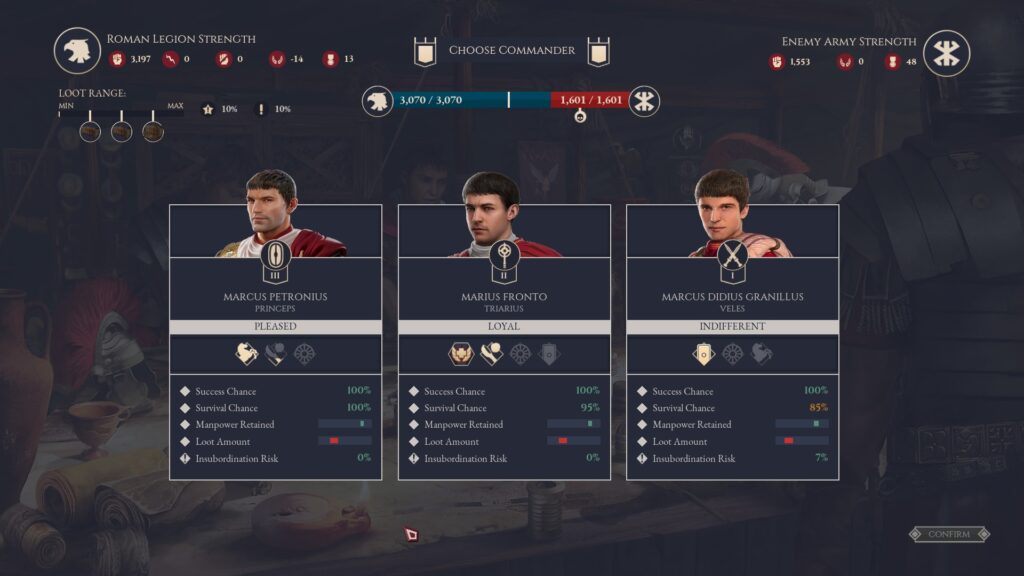
There is also a morale system for your companions and officers. Each character has personality traits that determine the sort of actions they approve and disapprove of. Many choices can gain favor with a certain personality type, and lose favor with another. As a character’s morale hits certain positive or negative thresholds, they might perform better in battle, or disobey orders if they are disgruntled with the way you run your legion.
This system has existed in previous Expeditions games, and largely works the same way here. Also, like previous games, its unfortunately kept needlessly vague and obfuscated. It’s a simple enough system to learn, but the exact values for each character’s morale aren’t visible. It merely says if they are “appalled,” “disgruntled,” “pleased,” “unwavering,” and so on.
You have no way of knowing how high or low in a specific bracket they are, making it difficult to gauge where each threshold begins and ends. The UI could perhaps benefit with this mechanic being a bar that increases and decreases so you have a better visual representation of each character’s morale.
Your time in Expeditions: Rome is divided between traveling across an overworld map, sending out your legion on missions, upgrading your camp, and entering towns or other places of interest.

At camp you can assign characters to tasks, such as refilling your tactical items, crafting weapons and armor, researching new stratagems, treating injuries, and so on. Each character will have perks that make them useful at specific jobs, like reducing the time it takes to craft, or raising legion morale if you let them have some leisure time at the baths. You will gradually upgrade your camp throughout the game, adding new facilities and upgrading the effectiveness of existing ones.
The overworld map is where you will do most of your exploring. The map is covered in loot stashes, towns, and other places of interest. As you travel, you’ll consume rations and water that must periodically be replaced at camp or in towns. You’ll often stumble on random encounters while travelling that will have a few different resolutions based on your choices. Some of these can have a positive or negative outcome, while others might be all negative and you just have to figure out what the lesser of two evils will be.
The predominately negative ones tend to appear more often when in enemy territory. While the random events are great, there’s unfortunately not nearly enough of them. Each region has their own set of events, but they can get repeated fairly often. I encountered the one about buying wine for my praetorians about 7 times before I was done with the Asia Minor section of the game.
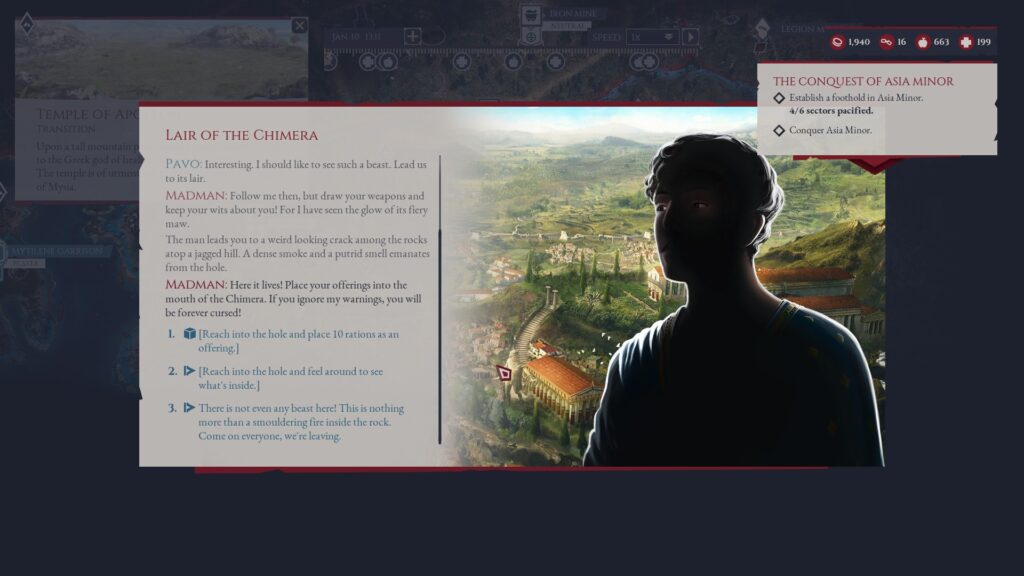
The overworld map also has plenty of towns where you can pick up side quests and buy resources. There are four core resources in the game: denarii, slaves, food, and medicine. While denarii are the primary currency of Rome, all four of these can be used in trading to some extent. Resources have their own exchange rates from region to region, meaning sometimes medicine or food might be worth way more than denarii.
Food, medicine, and slaves have their own uses as well. Food is consumed by your party as you travel, and might be used to resolve some events. Medicine is used to treat injured characters while on the road. Finally, slaves are required to purchase some upgrades and to capture various resource nodes like tanneries or mines.
It’s from the overworld map that you also control your legion. The map is divided into territories that each have a town or two, some resource nodes, and other points of interest. Taking over a region requires you to send your legion to conquer that area’s main city or capital. This brings up the game’s army battles mechanic, which is sadly kind of basic and boring.

The battles are ultimately just using some abilities to manipulate numbers in your favor. You start by selecting a centurion to lead the legion. The battle then commences, and you will have four chances to play stratagems that can affect the strength, morale, and overall outcome of the battle. You are given three choices of stratagem during these phases, with the choices being drawn randomly from your overall pool of learned stratagems.
That’s basically it. Each centurion has perks that can affect the battle’s outcome as well, but you are ultimately just using stratagems to manipulate the numbers a bit. If your legion is already really underpowered compared to an enemy army, then you really don’t have much control over the outcome. It’s really just down to reducing the risk of losing manpower or centurions, and increasing the loot and rewards for winning.
When doing my Expeditions: Rome review, I found the party-based tactical battles are way meatier and engaging. You will usually control 6 characters at once in most skirmishes, though there are some larger scale battles that typically mark the end of a region’s act. Each character is from one of 4 classes, and each class has 3 skill trees that further define their role on the battlefield. In general, the Princeps are your tanks and frontline brawlers, the Veles are your quick and lightly armored skirmishers, the Triarius are medium-armored spearmen and support characters, and the Sagittarius are your ranged archers.
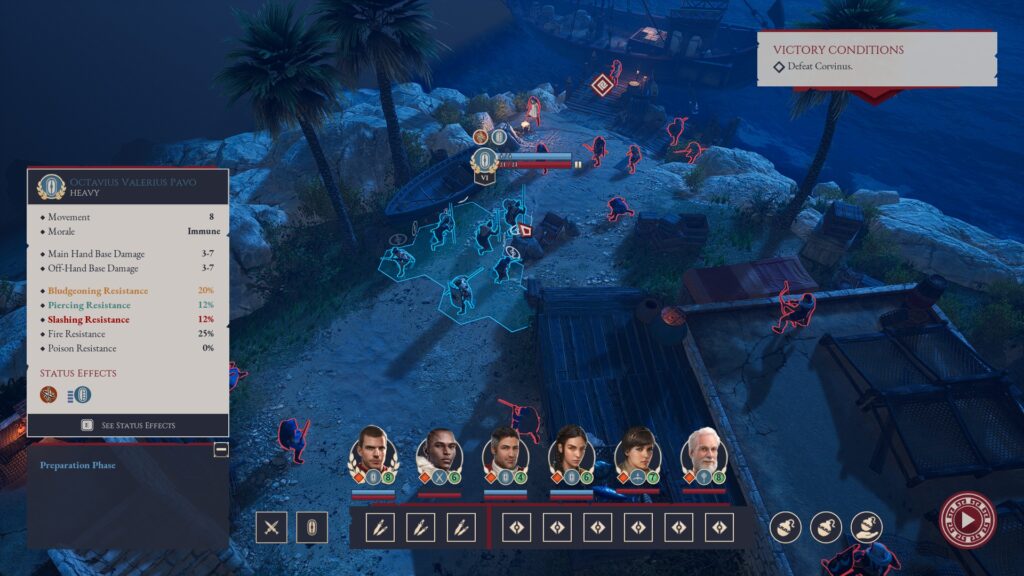
Each class has a selection of passive abilities and active skills that they can learn from their skill trees, as well as weapon and armor restrictions. The Princeps, for example, typically fights with heavy armor, spears, swords, and shields. Meanwhile, the Veles is limited to lighter armor classes, spears, and swords, but can also take a dagger in their offhand. Your weapons are very important in Expeditions: Rome, because they are where you get your actual attack skills.
Each character has 3 slots for attacks, and the attacks they have access to come from the weapons themselves. This means that the stat blocks aren’t the only thing to consider when equipping weapons. You might find a really rare sword with great stats, but aren’t too thrilled over the skills it comes with. This is where the game’s crafting system comes into play, allowing you to customize and upgrade pieces of gear you really like so they stay relevant for longer in the game.
The actual combat system in Expeditions: Rome is about what you’d expect from an XCOM-like strategy RPG system. Each character can move a set number of spaces and perform a single action. Alternatively, they can expend their action to run further up the field. There are also some “free” skills that can be used to modify other skills, or expend class specific resources to get extra attacks or actions.

Besides skills, your characters can also carry two tactical items. These include weapons like pilums, caltrops, jars of Greek Fire, torches, and so on. These tactical items have a set number of uses and don’t recharge between battles. You’ll need to replenish them at camp to get them back.
There is a fair amount of depth to the game’s combat system. Shields can deflect arrows and block damage, meaning you’ll need to destroy them with items like pilums or strong attacks. There are tons of combos you can build by combining certain weapon skills with the various passives and abilities of each class. Flanking enemies is important because you can deal extra damage and get around many traditional defenses. There’s also plenty of status effects and support skills that can hinder or bolster your characters.
Your characters can be further customized with a large range of cool loot. The game features various “mythological” weapons as legendary items you can find or craft on your journey, and they usually have pretty strong effects. Artemis’ Bow allows its wielder to make multiple overwatch shots per turn, while Aegis has a chance to blind enemies in melee. This is where the game’s upgrade system comes in really handy, ensuring that your favorite legendary weapons remain useful throughout the game.
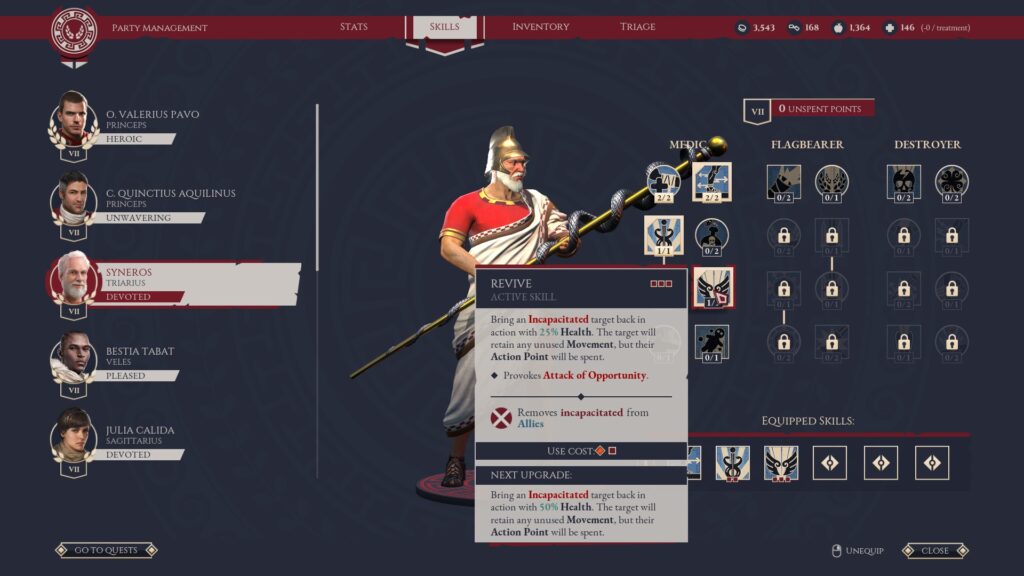
When doing my Expeditions: Rome review, I found the game is a great RPG that I really don’t have too many complaints about. The army battles are my biggest gripe because they really just aren’t that fun or interesting. Outside of that, the UI could use some basic quality of life enhancements.
The inventory’s sorting system is kind of awful, and there’s no way to dismantle multiple pieces of gear at once. You will stumble upon a lot of junk items in this game, and to get rid of them you will have to manually dismantle each and every one of them.
This involves holding the right mouse button for several seconds over the item you wish to scrap. As you might imagine, this gets tedious after a lengthy quest where you just picked up a dozen or so pieces of loot. Some of the tooltips and comparison views are also a bit clunky, relying on you to hold keys instead of just hovering over items.
The AI is generally pretty good, but does occasionally get stuck from time to time. There were a few instances of enemy pathfinding messing up, leaving a soldier stuck running in place for a few seconds. Speaking of which, there should be a way to speed up enemy turns. You will often be vastly outnumbered in battle, and it gets boring having to watch each and every enemy soldier’s turn play out in real time.
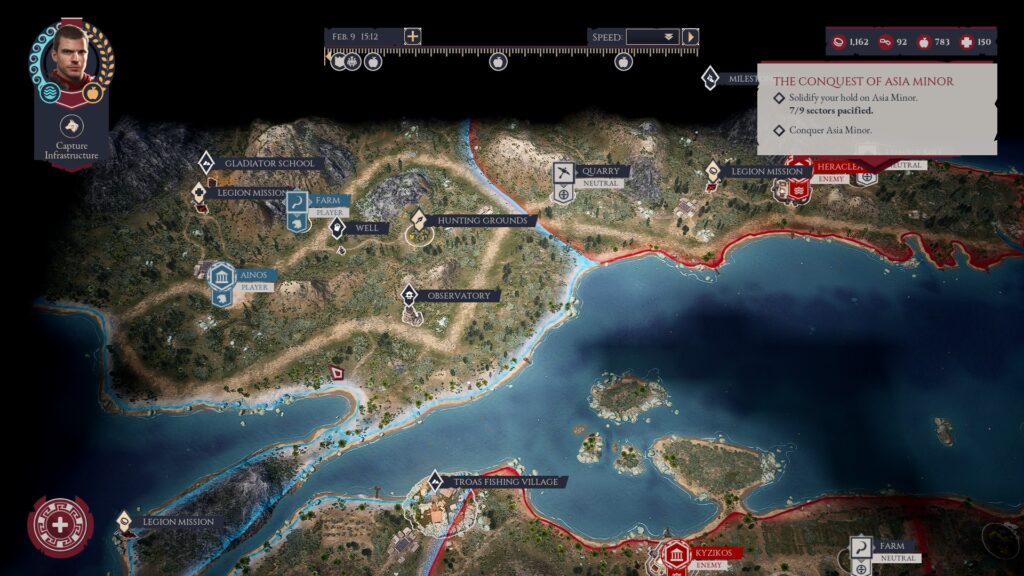
The developers should also add a way to “wait” while in camp too. Sometimes you just have to burn a few in-game hours for an upgrade to finish. In these cases, you have to exit camp, press the “play” button to fast-forward time, and then reenter camp to pick up your crafted items or whatever it was you were waiting for.
These complaints in my Expeditions: Rome review are all generally pretty minor, however. Expeditions: Rome is a very rewarding and engaging RPG that makes good use of its historical setting. It has an intriguing story featuring a fine cast of characters, solid voice acting, and hits a nice balance between authenticity and alternate history. The army battles are pretty unexciting, but the game’s turn-based tactical battles are great.
If you’ve never experienced an Expeditions game before, then Expeditions: Rome is a good starting point. It’s by far the most polished and refined game in the series, and features a variety of unique little ideas and mechanics you don’t really see in other RPGs. The first few months of the year are usually pretty slow in terms of releases, so now is the perfect time to dive into a lengthy RPG like Expeditions: Rome.
Expeditions: Rome was reviewed on Windows PC using a copy provided by THQ Nordic. You can find additional information about Niche Gamer’s review/ethics policy here. Expeditions: Rome is set to release on I.XX.MMXXII, or for you filthy non-Imperial Romans, Anno Domini 2022, on the 20th of Januarii. The game will be releasing for Windows PC via GOG and Steam.